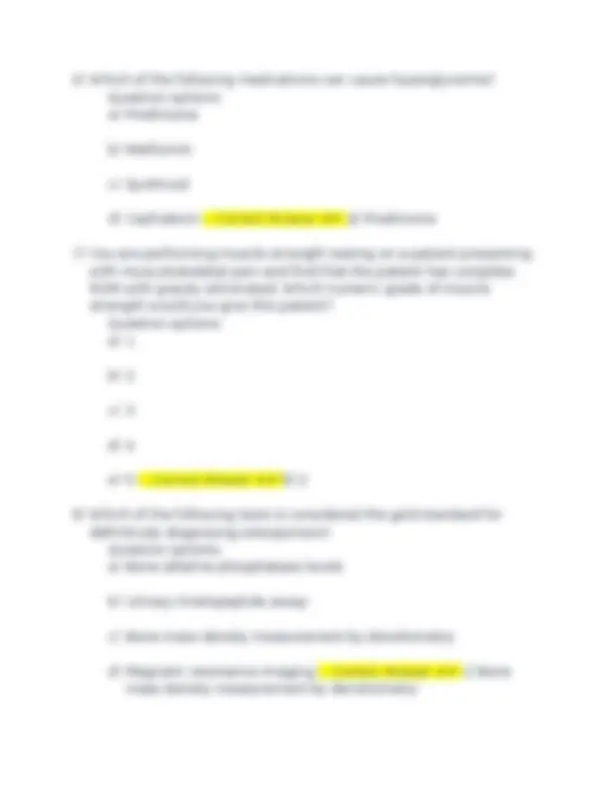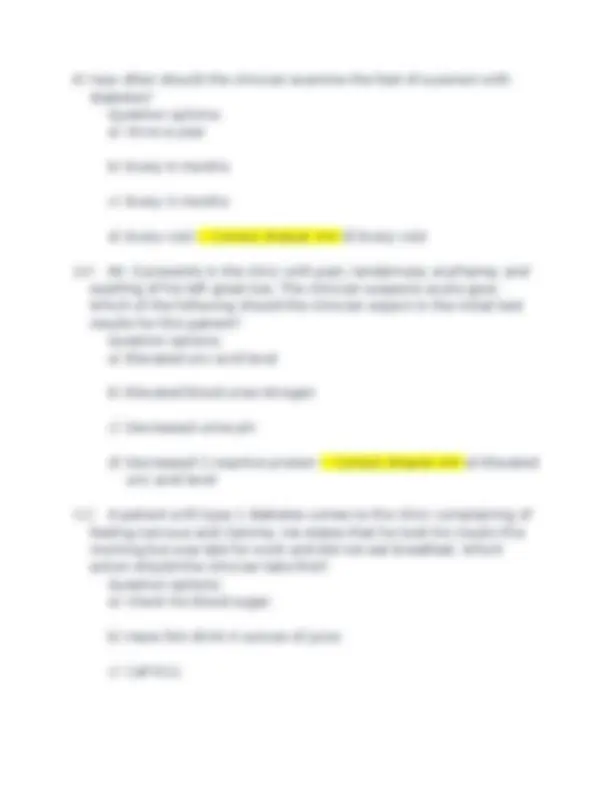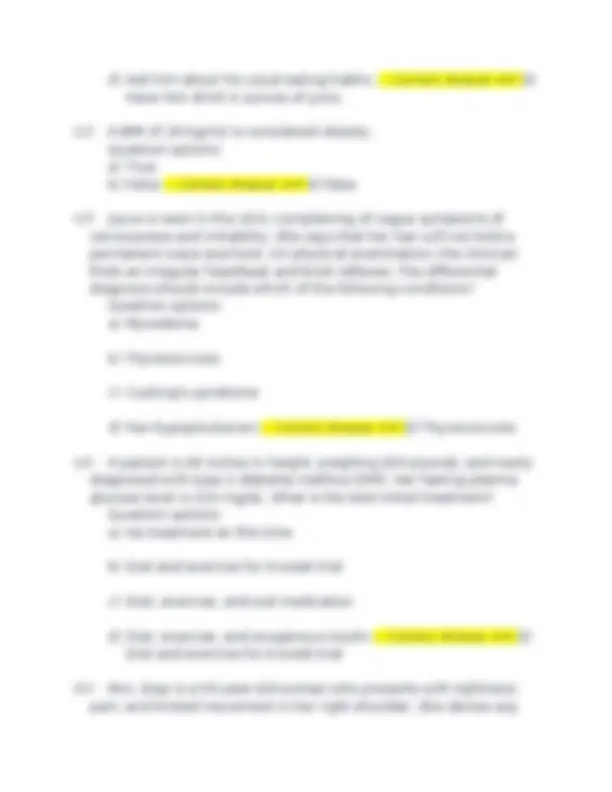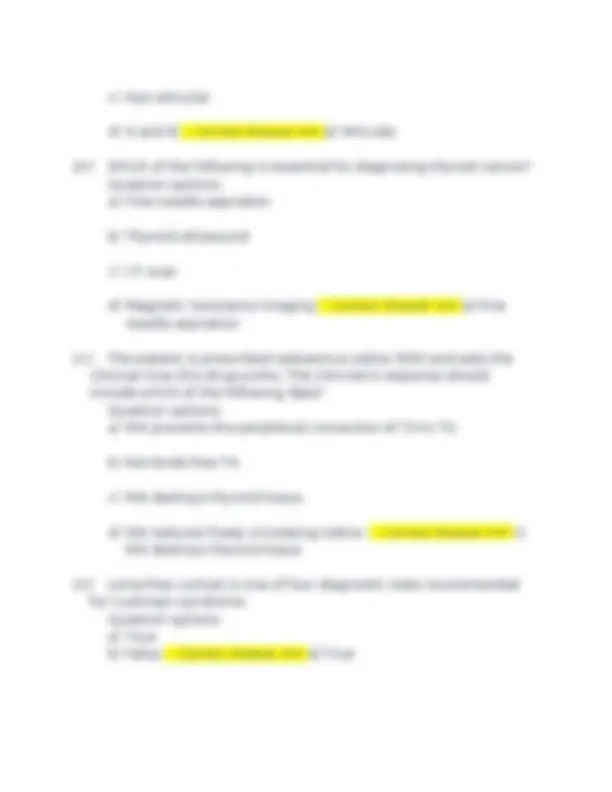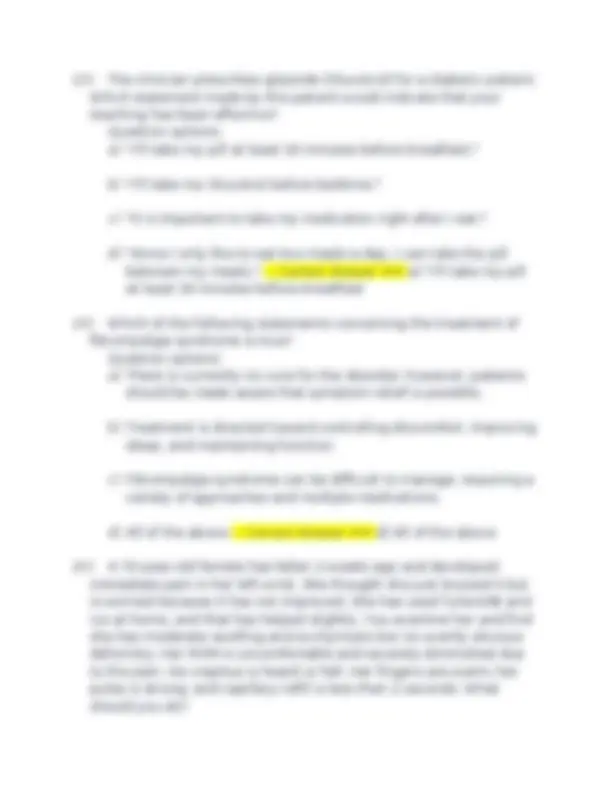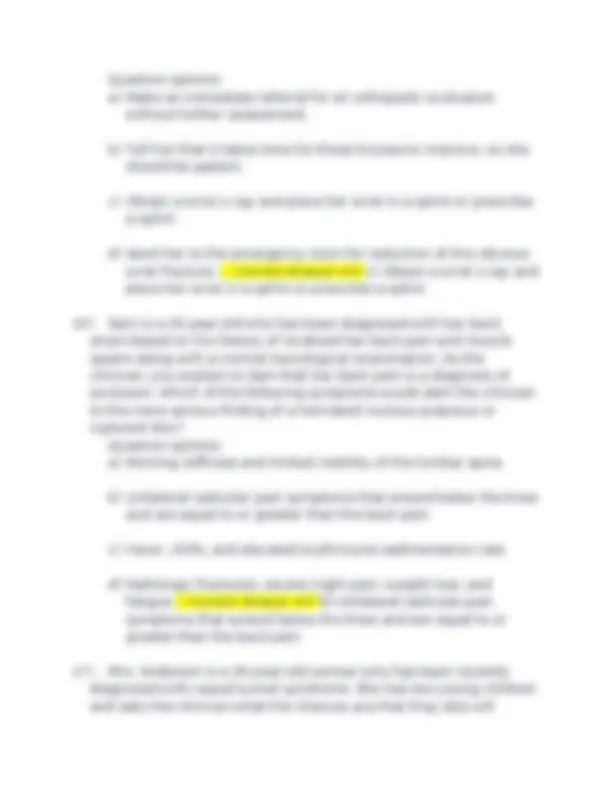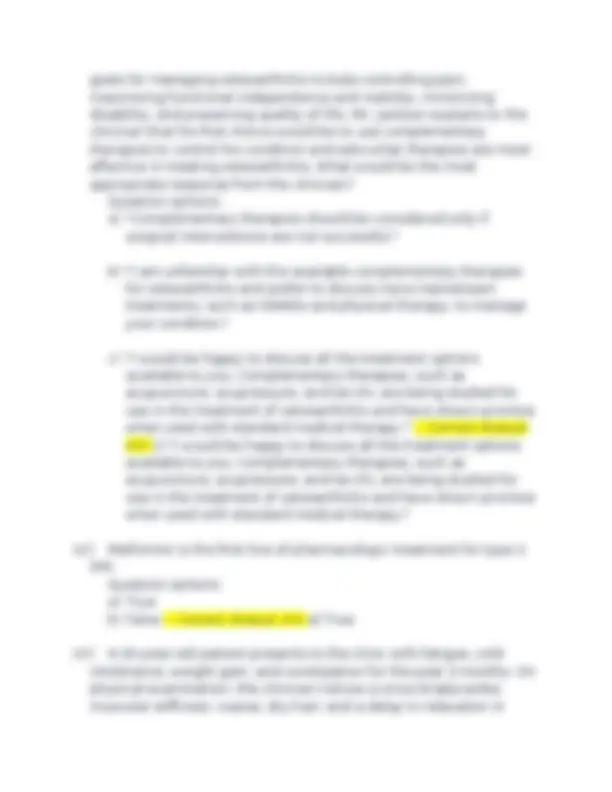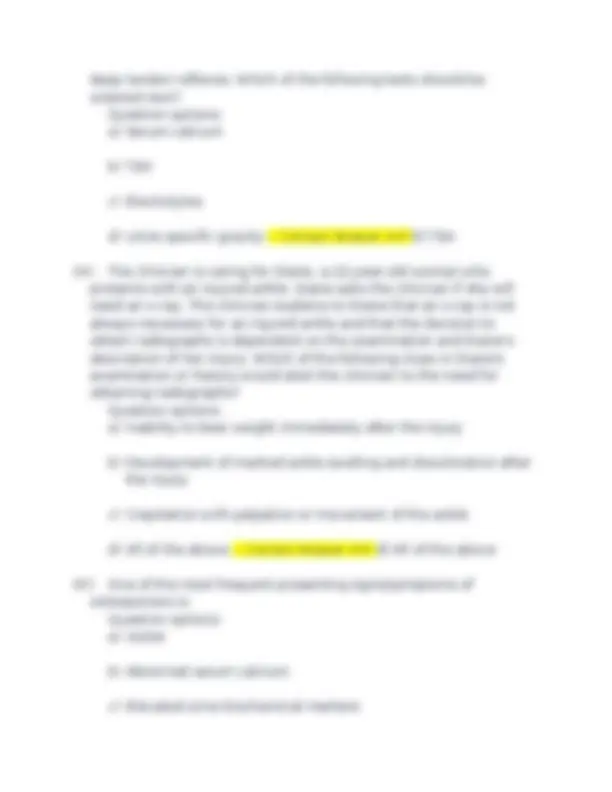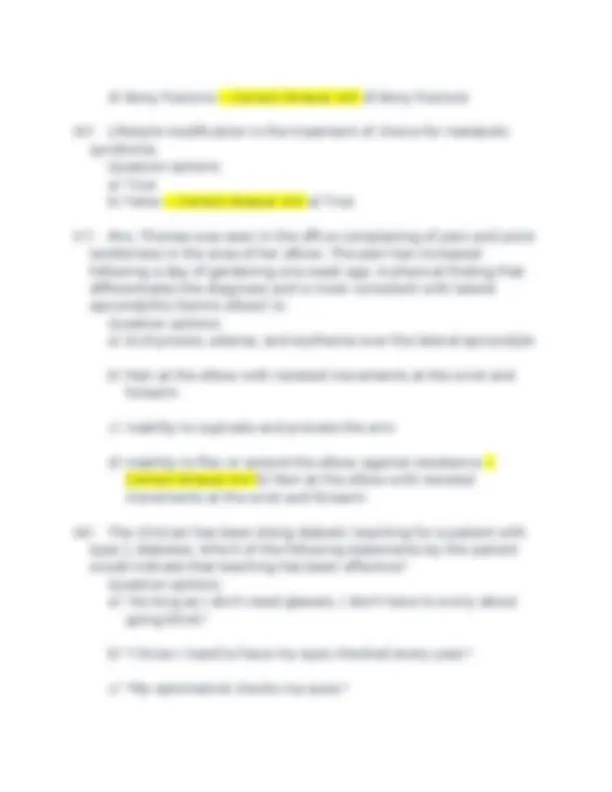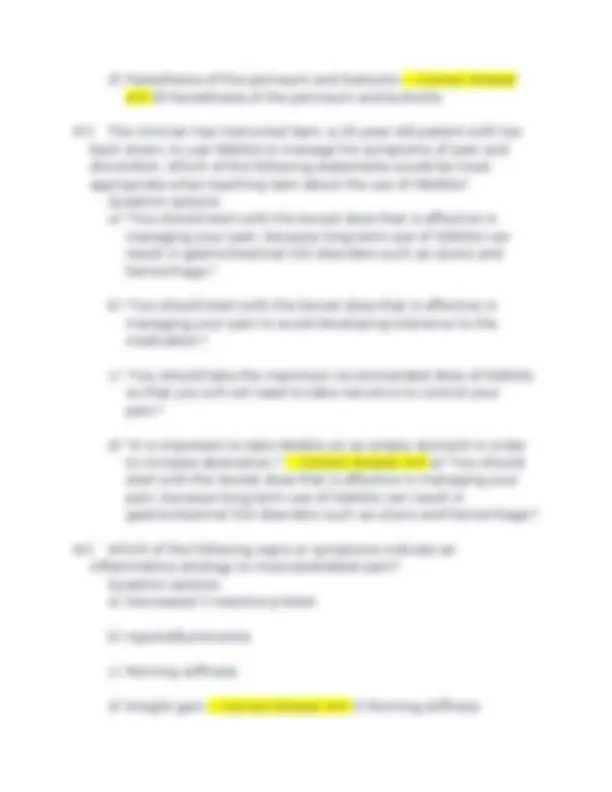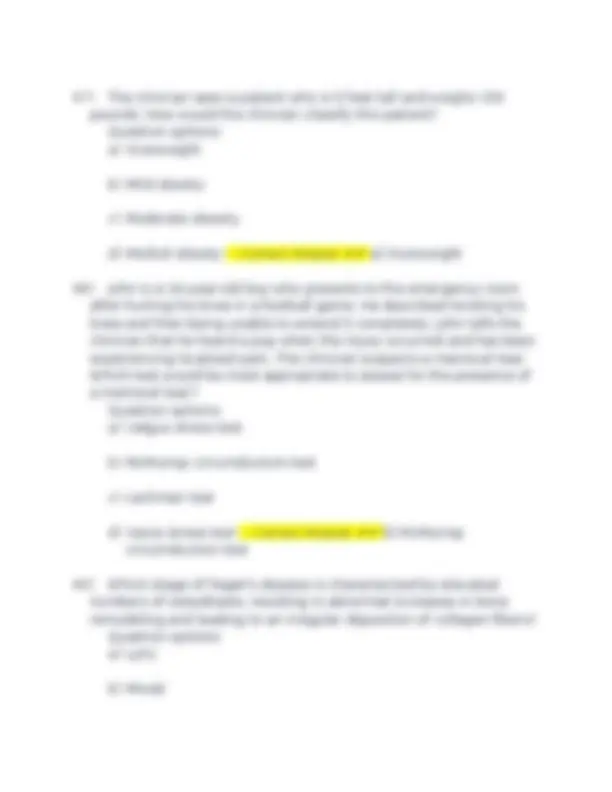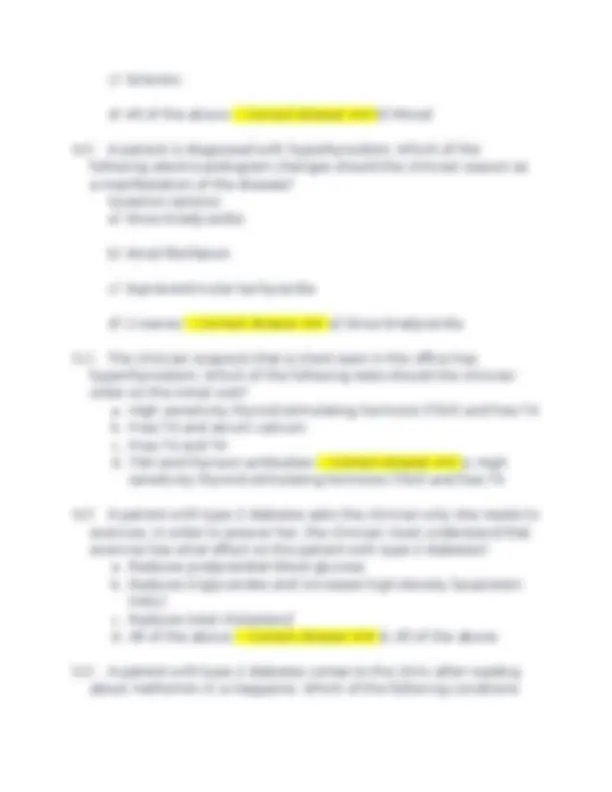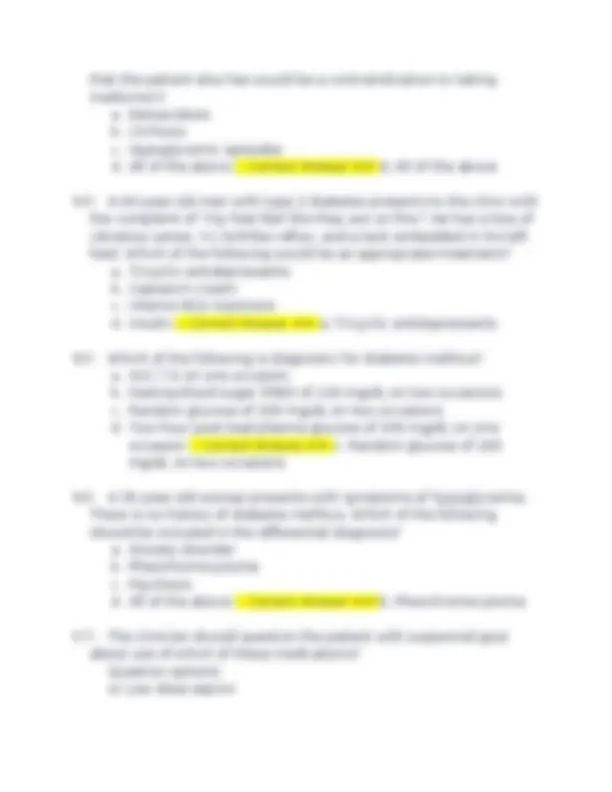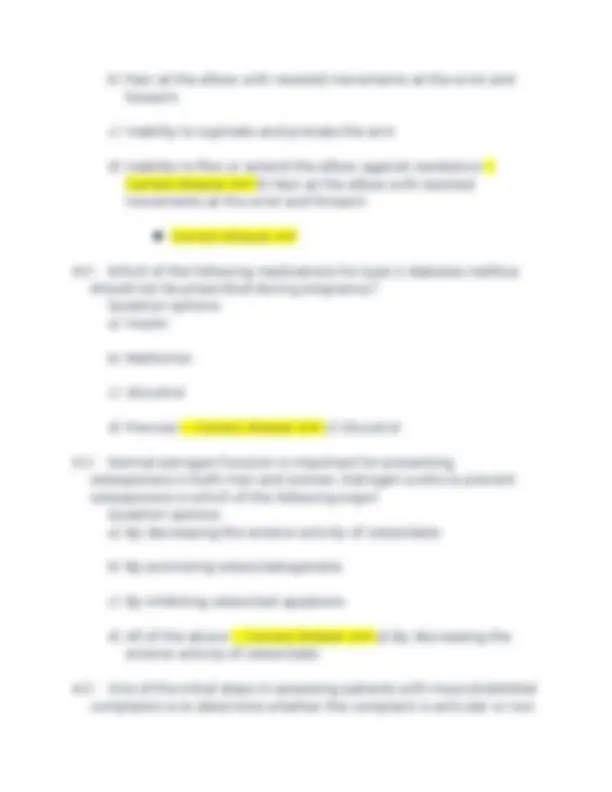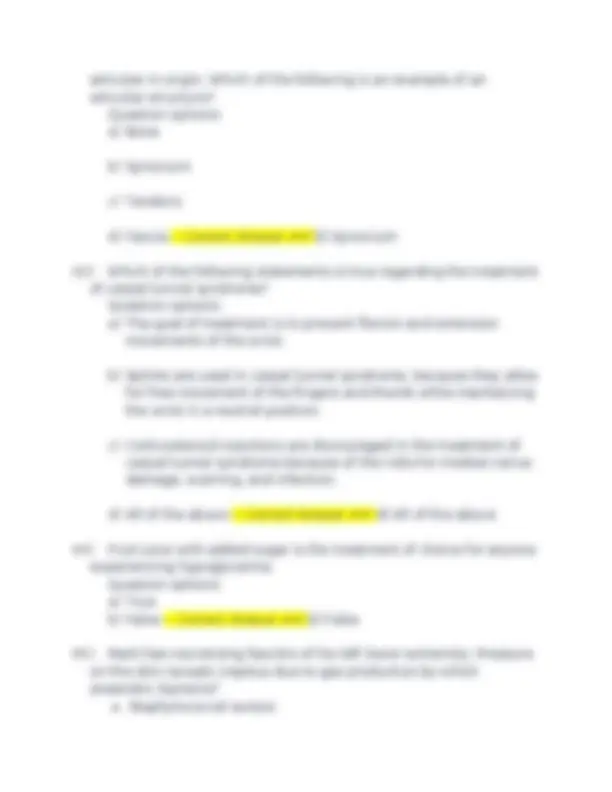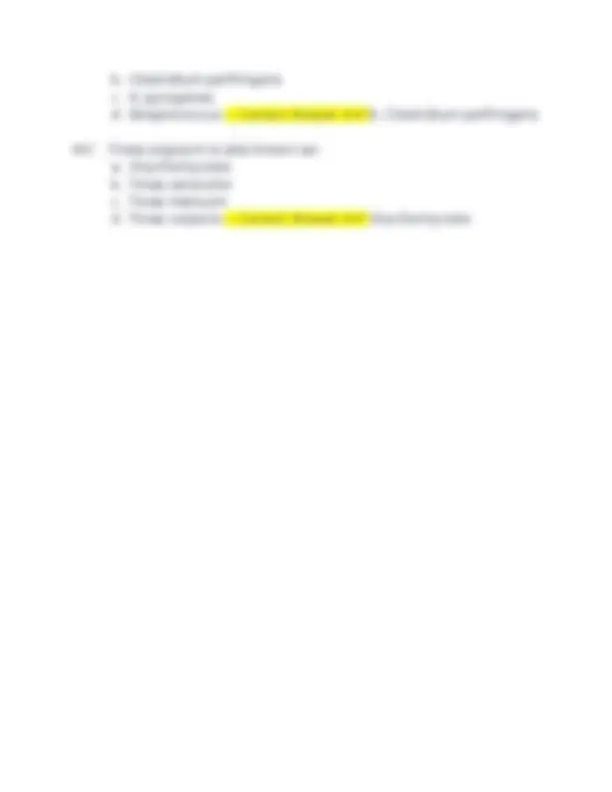Download Endocrinology & Musculoskeletal Health: MN 568 Exam Review and more Exams Nursing in PDF only on Docsity!
MN 568 FINAL EXAM QUESTIONS
WITH THE LATEST AND UPDATED
SCORE.
- After 6 months of Synthroid therapy, the clinician should expect which of the following in the repeat thyroid studies? Question options: a) Elevated TSH b) Normal TSH c) Low TSH d) Undetectable TSH -- Correct Answer ✔✔ b) normal TSH
- Which of the following is diagnostic for diabetes mellitus? Question options: a) A1C 7.0 on one occasion b) Fasting blood sugar (FBS) of 100 mg/dL on two occasions c) Random plasma glucose greater than or equal to 200 in a person with symptoms of hyperglycemia d) Two-hour post-load plasma glucose of 300 mg/dL on one occasion -- Correct Answer ✔✔ c) Random plasma glucose greater than or equal to 200 in a person with symptoms of hyperglycemia
- Which of the following statements is true regarding the treatment of carpal tunnel syndrome? Question options:
a) The goal of treatment is to prevent flexion and extension movements of the wrist. b) Splints are used in carpal tunnel syndrome, because they allow for free movement of the fingers and thumb while maintaining the wrist in a neutral position. c) Corticosteroid injections are discouraged in the treatment of carpal tunnel syndrome because of the risks for median nerve damage, scarring, and infection. d) All of the above -- Correct Answer ✔✔ d) All of the above
- What is the recommended daily calcium intake for adults over the age of 50 with low bone mass? Question options: a) 1,200 mg/day b) 1,000 mg/day c) 1,300 mg/day d) 1,500 mg/day -- Correct Answer ✔✔ d) 1,500 mg/day
- The clinician finds numerous nodules on the thyroid of a 65-year-old woman. The clinician suspects thyroid cancer. Which of the following data would be most significant for this patient? Question options: a) A history of tonsillectomy in the 1940s b) Recent exposure to mumps c) Vegetarian diet d) Allergy to iodine -- Correct Answer ✔✔ a) A history of tonsillectomy in the 1940s
- How often should the clinician examine the feet of a person with diabetes? Question options: a) Once a year b) Every 6 months c) Every 3 months d) Every visit -- Correct Answer ✔✔ d) Every visit
- Mr. S presents in the clinic with pain, tenderness, erythema, and swelling of his left great toe. The clinician suspects acute gout. Which of the following should the clinician expect in the initial test results for this patient? Question options: a) Elevated uric acid level b) Elevated blood urea nitrogen c) Decreased urine pH d) Decreased C-reactive protein -- Correct Answer ✔✔ a) Elevated uric acid level
- A patient with type 1 diabetes comes to the clinic complaining of feeling nervous and clammy. He states that he took his insulin this morning but was late for work and did not eat breakfast. Which action should the clinician take first? Question options: a) Check his blood sugar. b) Have him drink 4 ounces of juice. c) Call 911.
d) Ask him about his usual eating habits. -- Correct Answer ✔✔ b) Have him drink 4 ounces of juice.
- A BMI of 29 kg/m2 is considered obesity. Question options: a) True b) False -- Correct Answer ✔✔ b) false
- Joyce is seen in the clinic complaining of vague symptoms of nervousness and irritability. She says that her hair will not hold a permanent wave anymore. On physical examination, the clinician finds an irregular heartbeat and brisk reflexes. The differential diagnosis should include which of the following conditions? Question options: a) Myxedema b) Thyrotoxicosis c) Cushing's syndrome d) Pan-hypopituitarism -- Correct Answer ✔✔ b) Thyrotoxicosis
- A patient is 66 inches in height, weighing 200 pounds, and newly diagnosed with type 2 diabetes mellitus (DM). Her fasting plasma glucose level is 215 mg/dL. What is the best initial treatment? Question options: a) No treatment at this time b) Diet and exercise for 6-week trial c) Diet, exercise, and oral medication d) Diet, exercise, and exogenous insulin -- Correct Answer ✔✔ b) Diet and exercise for 6-week trial
- Mrs. Gray is a 55-year-old woman who presents with tightness, pain, and limited movement in her right shoulder. She denies any
c) "Monitoring glucose will promote a sense of control." d) All of the above -- Correct Answer ✔✔ d) All of the above
- Mrs. Allen is a 60-year-old woman who has been diagnosed with osteoporosis. She is very concerned about the risk of breast cancer associated with hormone replacement therapy and is wondering what other treatments are available to her. The clinician explains that bisphosphonates are another class of drugs used in the prevention and treatment of osteoporosis. What teaching should the clinician give Mrs. Allen in regard to taking bisphosphonates? Question options: a) Taking bisphosphonates can result in hypercalcemia, so calcium intake should be decreased while taking this class of drugs. b) There is potential for upper GI irritation, so these medications are contraindicated in people with abnormalities of the esophagus or delayed esophageal emptying. c) This class of drugs can be taken at any time of the day without regard to meals. d) None of the above -- Correct Answer ✔✔ b) There is potential for upper GI irritation, so these medications are contraindicated in people with abnormalities of the esophagus or delayed esophageal emptying.
- You have detected the presence of crepitus on examination of a patient with a musculoskeletal complaint. Additionally, there is limited range of motion (ROM) with both active and passive movement. These findings suggest that the origin of the musculoskeletal complaint is: Question options: a) Articular b) Inflammatory
c) Non articular d) A and B -- Correct Answer ✔✔ a) Articular
- Which of the following is essential for diagnosing thyroid cancer? Question options: a) Fine needle aspiration b) Thyroid ultrasound c) CT scan d) Magnetic resonance imaging -- Correct Answer ✔✔ a) Fine needle aspiration
- The patient is prescribed radioactive iodine (RAI) and asks the clinician how this drug works. The clinician's response should include which of the following data? Question options: a) RAI prevents the peripheral conversion of T4 to T3. b) RAI binds free T4. c) RAI destroys thyroid tissue. d) RAI reduces freely circulating iodine. -- Correct Answer ✔✔ c) RAI destroys thyroid tissue
- Urine-free cortisol is one of four diagnostic tests recommended for Cushing's syndrome. Question options: a) True b) False -- Correct Answer ✔✔ a) True
Question options: a) Make an immediate referral for an orthopedic evaluation without further assessment. b) Tell her that it takes time for these bruises to improve, so she should be patient. c) Obtain a wrist x-ray and place her wrist in a splint or prescribe a splint. d) Send her to the emergency room for reduction of this obvious wrist fracture. -- Correct Answer ✔✔ c) Obtain a wrist x-ray and place her wrist in a splint or prescribe a splint.
- Sam is a 25-year-old who has been diagnosed with low back strain based on his history of localized low back pain and muscle spasm along with a normal neurological examination. As the clinician, you explain to Sam that low back pain is a diagnosis of exclusion. Which of the following symptoms would alert the clinician to the more serious finding of a herniated nucleus pulposus or ruptured disc? Question options: a) Morning stiffness and limited mobility of the lumbar spine b) Unilateral radicular pain symptoms that extend below the knee and are equal to or greater than the back pain c) Fever, chills, and elevated erythrocyte sedimentation rate d) Pathologic fractures, severe night pain, weight loss, and fatigue -- Correct Answer ✔✔ b) Unilateral radicular pain symptoms that extend below the knee and are equal to or greater than the back pain
- Mrs. Anderson is a 35-year-old woman who has been recently diagnosed with carpal tunnel syndrome. She has two young children and asks the clinician what the chances are that they also will
develop carpal tunnel syndrome. Which of the following responses would be correct regarding the risk of developing carpal tunnel syndrome? Question options: a) Carpal tunnel syndrome commonly occurs in families. Genetic factors are thought to account for about one-half the risk of developing carpal tunnel. b) Only people with occupations that require repeated flexion extension of the wrist, use of hand tools that require forceful gripping, or use of hand tools that vibrate are at risk for developing carpal tunnel. c) An underlying musculoskeletal disorder must be present for a person to develop carpal tunnel. d) Carpal tunnel syndrome only occurs in the presence of a hormonal imbalance. -- Correct Answer ✔✔ a) Carpal tunnel syndrome commonly occurs in families. Genetic factors are thought to account for about one-half the risk of developing carpal tunnel.
- Which of the following statements concerning the musculoskeletal examination is true? Question options: a) The uninvolved side should be examined initially and then compared to the involved side. b) The part of the body that is causing the patient pain should be examined first. c) When possible, the patient should not be asked to perform active range-of-motion (ROM) exercises to avoid causing pain. d) Radiographs should always be obtained prior to examination so as not to cause further injury to the patient. -- Correct
goals for managing osteoarthritis include controlling pain, maximizing functional independence and mobility, minimizing disability, and preserving quality of life. Mr. Jackson explains to the clinician that his first choice would be to use complementary therapies to control his condition and asks what therapies are most effective in treating osteoarthritis. What would be the most appropriate response from the clinician? Question options: a) "Complementary therapies should be considered only if surgical interventions are not successful." b) "I am unfamiliar with the available complementary therapies for osteoarthritis and prefer to discuss more mainstream treatments, such as NSAIDs and physical therapy, to manage your condition." c) "I would be happy to discuss all the treatment options available to you. Complementary therapies, such as acupuncture, acupressure, and tai-chi, are being studied for use in the treatment of osteoarthritis and have shown promise when used with standard medical therapy." -- Correct Answer ✔✔ c) "I would be happy to discuss all the treatment options available to you. Complementary therapies, such as acupuncture, acupressure, and tai-chi, are being studied for use in the treatment of osteoarthritis and have shown promise when used with standard medical therapy."
- Metformin is the first line of pharmacologic treatment for type 2 DM. Question options: a) True b) False -- Correct Answer ✔✔ a) True
- A 25-year-old patient presents to the clinic with fatigue, cold intolerance, weight gain, and constipation for the past 3 months. On physical examination, the clinician notices a sinus bradycardia; muscular stiffness; coarse, dry hair; and a delay in relaxation in
deep tendon reflexes. Which of the following tests should be ordered next? Question options: a) Serum calcium b) TSH c) Electrolytes d) Urine specific gravity -- Correct Answer ✔✔ b) TSH
- The clinician is caring for Diane, a 22-year-old woman who presents with an injured ankle. Diane asks the clinician if she will need an x-ray. The clinician explains to Diane that an x-ray is not always necessary for an injured ankle and that the decision to obtain radiographs is dependent on the examination and Diane's description of her injury. Which of the following clues in Diane's examination or history would alert the clinician to the need for obtaining radiographs? Question options: a) Inability to bear weight immediately after the injury b) Development of marked ankle swelling and discoloration after the injury c) Crepitation with palpation or movement of the ankle d) All of the above -- Correct Answer ✔✔ d) All of the above
- One of the most frequent presenting signs/symptoms of osteoporosis is: Question options: a) Goiter b) Abnormal serum calcium c) Elevated urine biochemical markers
d) "I will see my eye doctor when my vision gets blurry." -- Correct Answer ✔✔ b) "I know I need to have my eyes checked every year."
- Osteoarthritis is primarily a noninflammatory condition. Question options: a) True b) False -- Correct Answer ✔✔ a) True
- A vegetarian patient with gout asks the clinician about food he should avoid. The clinician should advise the patient to avoid which of the following foods? Question options: a) Rice b) Carrots c) Spinach d) Potatoes -- Correct Answer ✔✔ c) Spinach
- Which of the following tests should you order to confirm Mr. W's diagnosis? Question options: a) Bone scan b) Computed tomography (CT) scan c) X-ray of the foot d) Culture of the ulcer -- Correct Answer ✔✔ c) X-ray of the foot
- Which of the following are common signs of type 2 DM? Question options: a) Anorexia
b) Recurrent yeast infection c) Weight gain d) Elevated HDL cholesterol -- Correct Answer ✔✔ b) Recurrent yeast infection
- Which of the following statements is true concerning the management of the client with a herniated disc? Question options: a) Muscle relaxants and narcotics can be used to control moderate pain but should be discontinued after 3 weeks of use. b) An epidural injection is helpful in reducing leg pain that has persisted for at least 3 weeks after the herniation occurred. c) Intolerable pain for more than a 3-month period is an indication for surgical intervention. d) All of the above -- Correct Answer ✔✔ c) Intolerable pain for more than a 3-month period is an indication for surgical intervention.
- Janet is a 30-year-old who has recently been diagnosed with a herniated disc at the level of L5-S1. She is currently in the emergency room with suspicion of cauda equina compression. Which of the following is a sign or symptom of cauda equina compression? Question options: a) Gastrocnemius weakness b) A reduced or absent ankle reflex c) Numbness in the lateral foot
- The clinician sees a patient who is 5 feet tall and weighs 150 pounds. How would the clinician classify this patient? Question options: a) Overweight b) Mild obesity c) Moderate obesity d) Morbid obesity -- Correct Answer ✔✔ a) Overweight
- John is a 16-year-old boy who presents to the emergency room after hurting his knee in a football game. He described twisting his knee and then being unable to extend it completely. John tells the clinician that he heard a pop when the injury occurred and has been experiencing localized pain. The clinician suspects a meniscal tear. Which test would be most appropriate to assess for the presence of a meniscal tear? Question options: a) Valgus stress test b) McMurray circumduction test c) Lachman test d) Varus stress test -- Correct Answer ✔✔ b) McMurray circumduction test
- Which stage of Paget's disease is characterized by elevated numbers of osteoblasts, resulting in abnormal increases in bone remodeling and leading to an irregular deposition of collagen fibers? Question options: a) Lytic b) Mixed
c) Sclerotic d) All of the above -- Correct Answer ✔✔ b) Mixed
- A patient is diagnosed with hypothyroidism. Which of the following electrocardiogram changes should the clinician expect as a manifestation of the disease? Question options: a) Sinus bradycardia b) Atrial fibrillation c) Supraventricular tachycardia d) U waves -- Correct Answer ✔✔ a) Sinus bradycardia
- The clinician suspects that a client seen in the office has hyperthyroidism. Which of the following tests should the clinician order on the initial visit? a. High sensitivity thyroid-stimulating hormone (TSH) and free T b. Free T4 and serum calcium c. Free T3 and T d. TSH and thyroxin antibodies -- Correct Answer ✔✔ a. High sensitivity thyroid-stimulating hormone (TSH) and free T
- A patient with type 2 diabetes asks the clinician why she needs to exercise. In order to answer her, the clinician must understand that exercise has what effect on the patient with type 2 diabetes? a. Reduces postprandial blood glucose b. Reduces triglycerides and increases high-density lipoprotein (HDL) c. Reduces total cholesterol d. All of the above -- Correct Answer ✔✔ d. All of the above
- A patient with type 2 diabetes comes to the clinic after reading about metformin in a magazine. Which of the following conditions

